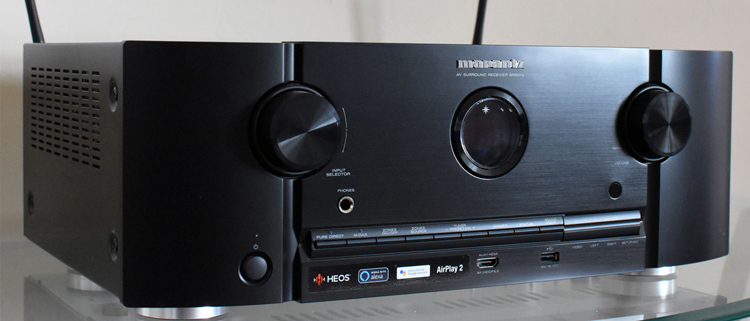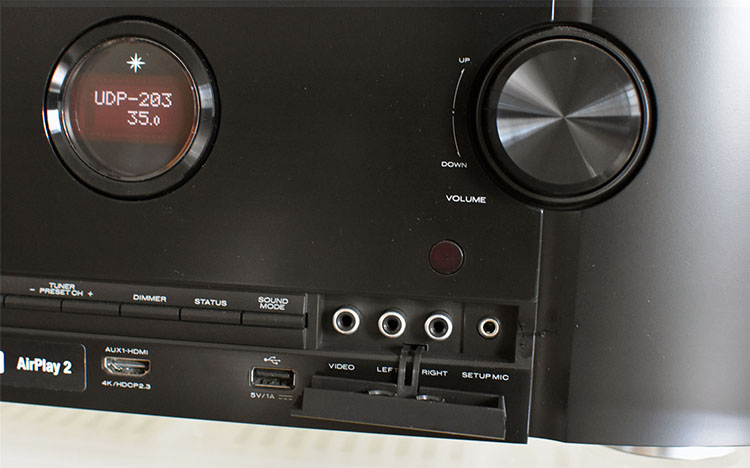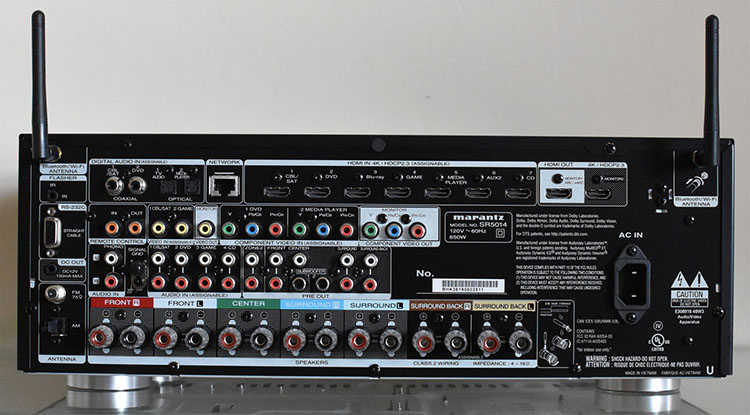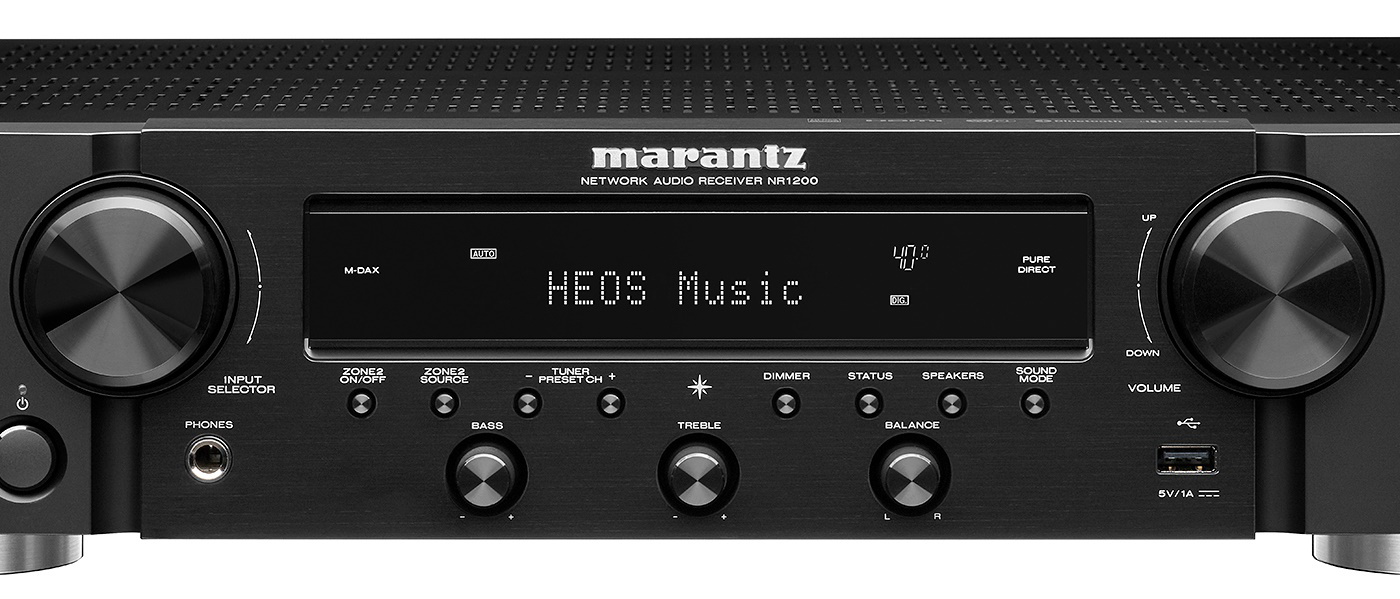
The company continually updates its family of products following the evolution of technology. The SR5014 receiver reviewed here is one of their latest offerings in Marantz’s ever-expanding home-theater receiver line. The SR5014 is quite feature-laden and equipped with the latest surround processing technology, which makes it very attractive at its mid-range price point. The review should provide the readers with some ideas on whether this receiver is worth considering in the mid-priced home-theater receiver category.
With its two round knobs flanking a round display on its front plate, this SR5014 carries a by-now classic Marantz look. This 7.2-channel receiver is a new addition to the extensive Marantz AV products. It offers and packs an impressive list of features, including advanced object-based audio formats (Dolby Atmos and DTS:X including their virtualization technology), 4k ultra-high-definition video processing capability, 24-bit/192-kHz digital-to-analog audio processing, full HDCP 2.3 HDMI support, and built-in HEOS feature, which allows for multi-room audio control and digital music streaming. It also supports integration with Amazon Alexa, Google Assistant, and Apple Siri, which enables convenient voice-control capability. The SR5014 also packs 7 channels of discrete amplification featuring 100 W per channel, which should be plenty for most applications. With the MSRP of $999, the SR5014 seems to offer a lot of bang for the buck.
Marantz SR5014 AV Receiver
- 7.2 channel with the latest Dolby Atmos and DTS:X surround processing formats and their virtualization technology
- 4K Ultra High-Def video upscaling and HDMI pass-through feature with HCDP 2.3 support.
- Wireless network control with HEOS (Home Entertainment Operating System) feature.
- 7 x 100 W powerful onboard amplifier.
Secrets Sponsor
The Marantz SR5014 is a new member of the Marantz receiver lineup superseding the SR5013. Released in the summer of this year, it carries the same price tag of $999 as its predecessor but it has a few updates, including HDCP 2.3 support and Dolby Atmos Height Virtualization processing. Marantz has been an active player in the AV receiver market, continually keeping up with the market demand. I know from my experience in owning Marantz products (I used to own their highly regarded AV8801 surround processor and now I have the AV8802 in my system), that the company is good in equipping their products with the latest bells and whistles to accommodate users demanding the state of the art of AV technologies without sacrificing the fundamental of quality sound reproduction. Therefore, I had some high expectations with the SR5014 and I approached the review with some curiosity on whether it has what it takes to fill these expectations.
Channels:
7.2 channel (dual subwoofer outputs)
Power:
7-channel discrete amplifier, 100W per channel (8-ohm, 20Hz – 20kHz, 0.08% THD 2-channels driven)
Multichannel audio processing:
Dolby Atmos, Dolby Atmos Height Virtualization, Dolby TrueHD, Dolby Surround, DTS:X, DTS Virtual:X, DTS HD Master, DTS Neural:X, Multichannel Stereo
HDMI connectivity:
8 HDMI inputs (1 HDMI input on the front panel) with full HDCP 2.3 support, 2 HDMI outputs with 1 HDMI output supporting eARC function
Video processing:
4K/60 Hz full-rate pass-through, 4:4:4 color resolution, HDR 10 and Dolby Vision compatibility
Audio inputs:
analog: 5 stereo line-level, 1 phono (MM), 1 USB
digital: 2 optical, 2 coaxial
Audio line-level outputs:
7.2 multichannel (2 subwoofer outs), 1 multi-room
Video inputs:
3 composites, 1 component
Video outputs:
1 composite, 1 component
High-resolution audio format decoding:
ALAC, FLAC and WAV lossless files up to 24-bit/192-kHz, DSD 2.8MHz and 5.6MHz
Wireless networking:
Bluetooth and built-in Wi-Fi with 2.4GHz/5GHz dual band support
Streaming support:
Spotify, Pandora, Tidal and more (music streaming services may vary by region) via AirPlay 2, HEOS app
HEOS Built-in:
for multi-room audio, voice control, and digital music streaming
Voice control:
Amazon Alexa, Google Assistant, and Apple Siri
Smartphone control:
Marantz AVR remote app available for iPhone and Android devices
Dimensions WxDxH:
17.3″ × 13.3″ × 6.3″
Color:
Black
Weight:
22.1 lbs.
MSRP:
$ 999 each
Company:
SECRETS Tags:
Marantz, AV Receiver, Marantz SR5014 AV Receiver, AV Receiver Review 2019
Just a quick glance at the Marantz SR5014 receiver, you will know that it comes from the Marantz family of products. It has the classic Marantz look with the faceplate featuring two big round knobs flanking the round display in the middle. The company seems to be in the groove with this faceplate design and why not? Although the round display can only show limited information, in my opinion, it is sufficient while at the same time giving a distinctive and handsome look. The SR5014 only comes in the black finish.
The Marantz SR5014 packs a long list of impressive features. It is a 7.2 channel receiver compatible with the latest multichannel audio formats such as Dolby Atmos, Dolby Atmos Height Virtualization, DTS:X, and DTS Virtual:X. The inclusion of Dolby Atmos Height Virtualization and DTS Virtual:X allows the simulation of the overhead sound effects without using the height-channel speakers. The seven-channel power amplifier inside the SR5014 delivers 100 W per channel, which should be sufficient for most applications. The weight of the receiver may not reflect that it has a 7 x 100 W amplifier onboard, as it is not that heavy, but its overall construction is good and feels quite sturdy.
Besides the two round knobs that function as an input selector and volume control, the front panel of the SR5014 is populated by functional buttons for powering the unit on/off and for selecting sound mode, zone, and tuner preset. A headphone connector, as well as extra HDMI and USB inputs, are also available. Hidden behind a plastic cover that can be popped open are a set of analog AV and the calibration microphone inputs. The SR5014 does come with the calibration microphone, which is part of the Audyssey MultEQ XT calibration and room-correction setup tool.

The rear panel of the SR5014 sports an extensive input/output connectivity. As typically with modern AV receiver these days, the SR5014 accommodates HDMI along with composite and component video inputs. On the audio side, connections for digital coax, optical, stereo analog, phono, and multi-channel inputs are provided. Seven pairs of speaker level outputs are located on the lower part of the rear panel. Line-level pre-outs are also available for all channels, to accommodate the use of an external amplifier. It is worth highlighting that the HDMI connections in the SR5014 supports the latest HDCP (HDCP2.3) and up to 4K 60Hz video format with the pass-through feature in standby mode. It is also capable of upscaling SD and HD video to 4K Ultra HD, a feature that was not in the inventory of mid-price receivers such as this just a few years back.

The network connectivity of the SR5014 is quite comprehensive. Besides the wired ethernet port, the SR5014 has built-in Bluetooth and dual-band 2.4GHz/5GHz Wi-Fi support. The SR5014 also has built-in HEOS (Home Entertainment Operating System) to maximize its wireless connectivity feature, enabling ease of control for multi-room audio, voice control, and digital music streaming. Besides the streaming access from your local NAS server, HEOS offers streaming support from popular streaming services like Pandora, Spotify, iHeart Radio, and TIDAL. The voice control feature allows hands-free playback functions using voice commands with Amazon Alexa, Google Assistant, or Apple Siri.
The remote control supplied has a slim aspect ratio with color-coded buttons that are clearly labeled. The Main and Zone2 buttons at the very top of the remote are backlit, but the rest are not. The remote was quite comfortable to hold due to its slim aspect ratio. I liked the fact that all the functions of the receiver could be accessed using the remote. But the remote operation of the SR5014 does not only stop there. The SR5014 supports 2 remote apps: the Marantz AVR Remote app as well as the HEOS app, which can be downloaded for free. The Marantz AVR Remote app is available for iOS and Android and can be used to control some functions of the receiver via the network, which include power on/off, volume adjustment, input selection, and access to the HEOS app. The HEOS app is needed to access streaming services and multi-room playback if you have more than one HEOS built-in devices. So, the Marantz SR5014 truly accommodates users with operational convenience at your fingertips.

Since the SR5014 is supplied with Audyssey calibration and room correction tool, its setup is in general quick and easy. I currently have the Marantz AV8802 in my system, which is equipped with the Audyssey MultEQ XT32, so I pretty much know the setup routine. If you connect your TV to the monitor out of the receiver, the step-by-step setup procedure is displayed on the screen when you first turn on the receiver, so you just need to follow the instructions. The whole process, from connecting the microphone to the receiver until the Audyssey analysis is completed, takes less than 15 minutes. You can then verify the Audyssey analysis results, which includes speaker configuration, distances to the main listening position, speaker sizes, and channel levels, and make the manual fine-tuning if necessary. In my case, I found the Audyssey calibration results to be pretty spot-on, so I just used it without making additional adjustments.
Secrets Sponsor
During the review, I connected the SR5014 to my home network using Wi-Fi. The Wi-Fi setup is part of the initial setup step-by-step on-screen guide, although you can always set it up separately by accessing its menu. Connection to the network is essential for the HEOS utilization and for accessing the online music subscriptions like Spotify or Tidal. With the network connection, you can also play the music collection stored in your home NAS through the SR5014. An added bonus of connecting the receiver to the network is the provision of the use of the Marantz AVR Remote app for controlling the receiver remotely from any room in the house. This is especially handy if the receiver is set up for a multi-room application.
First off after the setup, I noticed that the HDMI performance of the SR5014 was very respectable. I did not have a means to specifically measure its video performance, but I did not notice any degradation of video when passed through the receiver. When the HDMI control is set to on and the AVR playback mode is selected, which means the audio is delivered through the speakers connected to the receiver, the receiver will be automatically awakened when the connected HDMI input is turned on.
I utilized this setting during the review, which turned the receiver on when I turned on my cable box, so the video was displayed on my TV but the audio was handled by the receiver. Most of the time this process ran smoothly. However, occasionally, I experienced a hiccup with the video. The receiver turned on and played the audio of the program, but the video stayed blank. Not sure whether this was a software glitch or an issue with component compatibility, but since it only happened rarely, it did not bother me too much. Restarting the receiver usually remedied the situation.
On the audio side, the Marantz SR5014 competently produced strong surround performance from the various sources I threw at it. Be it a TV program or movie soundtrack, the receiver always gave me clear and crisp sonic surround envelopment, which allowed me to engage more with the program material. Its onboard amplifier demonstrated more-than-sufficient power to drive my speakers to high-level volume without any trace of congestion.
I thoroughly enjoyed my experience watching The Sinner season 2 series from Netflix through the SR5014. The series contained subdued dialogue, fast-pace sequences, and underlying background music that affected the mood of scenes a great deal, and the SR5014 effortlessly navigated through all these with ease. The dialogue was clear and natural sounding. The layering of background music that contained a lot of rhythmic thumping was delivered with a deep sense of envelopment.

On movies such as Thor Ragnarok, the SR5014 handled the Dolby Atmos soundtrack of complex action sequences convincingly. Its surround steering felt accurate with sounds coming from seemingly the right directions as the actions on the scenes.
The Dolby Atmos Height Virtualization seemed to give added height dimension to some scenes, for example on the one where Thor was pulled by the hammer up to the sky, more so than when the Speaker Virtualization setting was set to off. Even during the busy action sequences, the SR5014 managed to deliver the dialogue unmuddied by the surrounding sound effects.

Even though the receiver was evaluated mostly for its 7.1 surround applications, I did spend some time evaluating its performance in stereo 2.1 music applications. Overall, the SR5014 delivered satisfying stereo performance that complemented its strong surround performance. Music was generally reproduced with good dynamics, full of textures, and never sounded flat through the SR5014. The Hardest Part track from Laura Welsh’s Soft Control album (2015) displayed the well-balanced dynamics of the sonic performance of the receiver as well as its capability to reproduce full-bodied vocals.

The SR5014’s shortcomings when it came to its stereo performance were only noticeable when compared to its much-more-expensive Marantz AV8802 surround processor sibling. The SR5014 did not have the last word on vocal smoothness, treble airiness, and image depth in this comparison.
But this was not a fair price-point comparison and as a one-box, AV control solution, the SR5014’s strong suits on most aspects of its sonic performance more than makes up for these minor shortcomings.
The MARANTZ SR5014 is a feature-laden mid-priced receiver with a well-rounded performance that is worthy of its $999 price tag.
- Handsome-looking receiver with good build quality
- Comprehensive connectivity and features
- Excellent networking and wireless features
- Powerful onboard amplifier
- Equipped with the latest Dolby Atmos and DTS:X surround virtualization technology
- Very good stereo and surround performance
- Other-color finish options
- Backlit remote control
At the beginning of the review, I mentioned that I approached the SR5014 receiver with high expectations. I am glad to report that the receiver met my expectations and then some. The Marantz SR5014 is a mid-priced AV receiver with a high-end attitude. It is well built and packed with a powerful 7 x 100 Watts amplifier onboard. It is also equipped with state-of-the-art surround format processing and extensive input/output connectivity that will accommodate most users’ AV needs. The addition of the HEOS feature enhances the convenience of the receiver’s networking operations. More importantly, the SR5014 delivers strong sonic performance in both stereo and home-theater applications. For people who are looking for a one-box central AV controller solution for their system within the $1000 price range, the SR 5014 is a must audition. Its comprehensive features and well-rounded performance could easily win them over.



